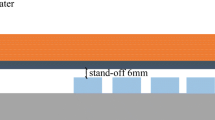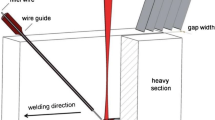Abstract
Explosive welding quality is deeply related to the interface morphology, and the interface morphology is mainly dependent on some process parameters such as collision velocity, welding angle, and material strength (Zeng et al. Weld World 63:967–974. 1; Zeng et al. Met Mater Eng 49(6):1977-1983. 2; Zeng et al. Baozha Yu Chongji/Explosion Shock Waves 39(5): 7. 3). In this paper, the quantitative prediction method of explosive welding interface morphology was investigated based on the fluid elastoplastic theory and experimental results. In addition, a model of shock wave propagation was proposed to study the gas movement in the gap between the plates during the welding process. The results showed that good agreement of interface morphology can be observed between the quantitative calculation results and the experiment results. The “channel effect” of gas shock wave between the base and cladding plates was proposed, which can cause the tail of the cladding plate to be lifted and change the welding parameters before the collision.







Similar content being viewed by others
References
Zeng X, Li X, Chen X, Wang X, Yan H (2019) Numerical and experimental studies on the explosive welding of plates with different initial strength. Weld World 63:967–974. https://doi.org/10.1007/s40194-019-00733-0
Zeng X, Li X, Wang X, Yan H, Li K(2020) Formation and development of explosive welding wave interface, Xiyou Jinshu Cailiao Yu Gongcheng/Rare Met. Mater. Eng. 49(6):1977~1983. http://www.rmme.ac.cn/rmmeen/ch/reader/view_abstract.aspx?file_no=20190333&flag=1
Zeng X, Li X, Cao J, Wang X, Yan H(2019) Interface characteristics of explosive welding for different strength plates, Baozha Yu Chongji/Explosion Shock Waves. 39(5): 7. https://doi.org/10.11883/bzycj-2018-0400
Bataev I, Tanaka S, Zhou Q, Lazurenko D, Junior A, Bataev A, Hokamoto K, Mori A, Chen P (2019) Towards better understanding of explosive welding by combination of numerical simulation and experimental study. Mater Des 169:107649. https://doi.org/10.1016/j.matdes.2019.107649
Harris I(1993)Welding brazing and soldering, Engineering. (1993). https://doi.org/10.1017/CBO9781107415324.004.
Kundu S, Ghosh M, Laik A, Bhanumurthy K et al (2005) Chatterjee, Diffusion bonding of commercially pure titanium to 304 stainless steel using copper interlayer. Mater Sci Eng A 407:154–160. https://doi.org/10.1016/j.msea.2005.07.010
Guo X, Wang H, Liu Z et al (2015) Interface and performance of CLAM steel / aluminum clad tube prepared by explosive bonding method. Int J Adv Manuf Technol 82:543–548. https://doi.org/10.1007/s00170-015-7380-z
Cherepanov A, Maliutina I (2016) Laser welding of stainless steel to titanium using explosively welded composite inserts. Int J Adv Manuf Technol 90:3037–3043. https://doi.org/10.1007/s00170-016-9657-2
Yin J, Peng G, Chen C, Yang J et al (2018) Thermal behavior and grain growth orientation during selective laser melting of Ti-6Al-4V alloy. J Mater Process Technol 260:57–65. https://doi.org/10.1016/j.jmatprotec.2018.04.035
Santos JF, Staron P, Fischer T et al (2018) Understanding precipitate evolution during friction stir welding of Al-Zn-Mg-Cu alloy through in-situ measurement coupled with simulation. Acta Mater 148(15):163–172. https://doi.org/10.1016/j.actamat.2018.01.020
Carl LR (1994) Brass welds made by detonation impulse. Met Prog 1994:102–103
Xu W, Birbilis N, Sha G, Wang Y, Daniels JE, Xiao Y, Ferry M (2015) A high-specific-strength and corrosion-resistant magnesium alloy. Nat Mater 14:1229–1235. https://doi.org/10.1038/nmat4435
Ning J, Zhang L, Xie M, Yang H, Yin X, Zhang J (2017) Microstructure and property inhomogeneity investigations of bonded Zr/Ti/steel trimetallic sheet fabricated by explosive welding. J Alloys Compd 698:835–851. https://doi.org/10.1016/j.jallcom.2016.12.213
Kaya Y, Kahraman N, Durgutlu A, Gülenç B (2017) Investigation of the microstructural, mechanical and corrosion properties of grade A ahip steel-duplex stainless steel composites produced via explosive welding, Metall. Mater Trans A Phys Metall Mater Sci 48:3721–3733. https://doi.org/10.1007/s11661-017-4161-3
Wang Y, Li X, Wang X, Yan H (2018) Fabrication of a thick copper-stainless steel clad plate for nuclear fusion equipment by explosive welding, Fusion Eng. Des 137:91–96. https://doi.org/10.1016/j.fusengdes.2018.08.017
Liu R, Wang W, Zhang T, Yuan X (2017) Numerical study of Ti/Al/Mg three-layer plates on the interface behavior in explosive welding. Sci Eng Compos Mater 24:833–843. https://doi.org/10.1515/secm-2015-0491
Baoxiang R, Gang T, Peng W, Changxing D (2019) Study on weldability window and interface morphology of steel tube and tungsten alloy rod welded by explosive welding. Int J Refract Met Hard Mater 84:105005. https://doi.org/10.1016/j.ijrmhm.2019.105005
Paul H, Morgiel J, Baudin T, Brisset F, Prażmowski M, Miszczyk M (2014) Characterization of explosive weld joints by TEM and SEM/EBSD, Arch. Metall. Mater. 59.https://doi.org/10.2478/amm-2014-0197
Prażmowski M (2014) Mechanical properties of zirconium/steel bimetal fabricated by means of explosive welding at varied detonation velocities. Arch Metall Mater 59:1134–1142. https://doi.org/10.2478/amm-2014-0198
Prażmowski M, Rozumek D, Paul H(2017) Influence of the microstructure on the fatigue cracks growth in the joint zirconium-steel made by explosive welding, Solid State Phenom. 258 SSP: 619–622. https://doi.org/10.4028/www.scientific.net/SSP.258.619 .
Zhang T, Wang W, Zhang W, Wei Y, Cao X, Yan Z, Zhou J (2018) Microstructure evolution and mechanical properties of an AA6061/AZ31B alloy plate fabricated by explosive welding. J Alloys Compd 735:1759–1768. https://doi.org/10.1016/j.jallcom.2017.11.285
Kurek A, Wachowski M, Niesłony A, Płociñski T, Kurzydłowski KJ (2014) Fatigue tests and metallographic of explosively cladded steel-titanium bimetal. Arch Metall Mater 59:1566–1570. https://doi.org/10.2478/amm-2014-0265
Bataev IA, Ogneva TS, Bataev AA et al (2015) Explosively welded multilayer Ni-Al composites. Mater Des 88:1082–1087. https://doi.org/10.1016/j.matdes.2015.09.103
Liu L, Jia YF, Xuan FZ (2017) Gradient effect in the waved interfacial layer of 304L/533B bimetallic plates induced by explosive welding. Mater Sci Eng A 704:493–502. https://doi.org/10.1016/j.msea.2017.08.012
Wronka B (2011) Testing of explosive welding and welded joints. Wavy character of the process and joint quality. Int J Impact Eng 38:309–313. https://doi.org/10.1016/j.ijimpeng.2010.11.003
Aizawa Y, Nishiwaki J, Harada Y, Muraishi S, Kumai S (2016) Experimental and numerical analysis of the formation behavior of intermediate layers at explosive welded Al/Fe joint interfaces. J Manuf Process 24:100–106. https://doi.org/10.1016/j.jmapro.2016.08.002
Mousavi AAA, Al-Hassani STS (2005) Numerical and experimental studies of the mechanism of the wavy interface formations in explosive/impact welding. J Mech Phys Solids 53:2501–2528. https://doi.org/10.1016/j.jmps.2005.06.001
Zhang Z, Liu M (2019) Numerical studies on explosive welding with ANFO by using a density adaptive SPH method. J Manuf Process 41:208–220. https://doi.org/10.1016/j.jmapro.2019.03.039
Liu M, Zhang Z, Feng D (2017) A density-adaptive SPH method with kernel gradient correction for modeling explosive welding. Comput Mech 60:513–529. https://doi.org/10.1007/s00466-017-1420-5
Zhang Z, Feng D, Liu M (2018) Investigation of explosive welding through whole process modeling using a density adaptive SPH method. J Manuf Process 35:169–189. https://doi.org/10.1016/j.jmapro.2018.08.004
Habib M, Keno H, Uchida R, Mori A, Hokamoto K (2015) Cladding of titanium and magnesium alloy plates using energy-controlled underwater three layer explosive welding. J Mater Process Tech 217:310–316. https://doi.org/10.1016/j.jmatprotec.2014.11.032
Sun W, Li X, Hokamoto K (2013) Numerical simulation of underwater explosive welding process. Mater Sci Forum 767:120–125. https://doi.org/10.4028/www.scientific.net/MSF.767.120
Sun W, Li X, Yan H, Hokamoto K (2014) Effect of initial hardness on interfacial features in underwater explosive welding of tool steel SKS3. J Mater Eng Perform 23:421–428. https://doi.org/10.1007/s11665-013-0778-6
Narayan S, Tanaka S, Mori A, Hokamoto K (2017) Welding of Sn and Cu plates using controlled underwater shock wave. J Mater Process Technol 245:300–308. https://doi.org/10.1016/j.jmatprotec.2017.02.030
Satyanarayan MA, Nishi M, Hokamoto K (2019) Underwater shock wave weldability window for Sn-Cu plates. J Mater Process Technol 267:152–158. https://doi.org/10.1016/j.jmatprotec.2018.11.044
Chen X, Inao D, Tanaka S, Mori A, Li X, Hokamoto K (2020) Explosive welding of Al alloys and high strength duplex stainless steel by controlling energetic conditions. J Manuf Process 58:1318–1333. https://doi.org/10.1016/j.jmapro.2020.09.037
Li X, Ma H, Shen Z (2015) Research on explosive welding of aluminum alloy to steel with dovetail grooves. Mater Des 87:815–824. https://doi.org/10.1016/j.matdes.2015.08.085
Ma R, Wang Y, Wu J, Duan M (2014) Explosive welding method for manufacturing ITER-grade 316L(N)/CuCrZr hollow structural member, Fusion Eng. Des 89:3117–3124. https://doi.org/10.1016/j.fusengdes.2014.10.001
Zhang D, Li G, Zhou Z, Shao B (1984) Effect of material strength on forming process of explosive welding interface wave, Chinese. J Theor Appl Mech 16:73–80. https://doi.org/10.6052/0459-1879-1984-1-1984-009
Li K, Li X, Yan H, Wang X, Wang Y (2018) Study of continuous velocity probe method for the determination of the detonation pressure of commercial explosives. J Energ Mater 00:1–9. https://doi.org/10.1080/07370652.2018.1425310
Thoraval MJ, Takehara K, Etoh TG et al (2012) Von Kármán vortex street within an impacting drop. Phys Rev Lett 108:264506. https://doi.org/10.1103/PhysRevLett.108.264506
Zeng X, Wang Y, Li X, Li X, Zhao T (2019) Effect of inert gas-shielding on the interface and mechanical properties of Mg / Al explosive welding composite plate. J Manuf Process 45:166–175. https://doi.org/10.1016/j.jmapro.2019.07.007
Zeng X, Wang Y, Li X, Li X, Zhao T (2019) Effects of gaseous media on interfacial microstructure and mechanical properties of titanium/steel explosive welded composite plate. Fusion Eng Des 148:111292. https://doi.org/10.1016/j.fusengdes.2019.111292
Funding
This study was funded by the National Natural Science Foundation of China (Nos: 10672068, 10972051, 10672067). Special thanks to Professor Li for his guidance and help over the past four years.
Author information
Authors and Affiliations
Corresponding author
Ethics declarations
Conflict of interest
The authors declare no competing interests.
Additional information
Publisher's note
Springer Nature remains neutral with regard to jurisdictional claims in published maps and institutional affiliations.
Recommended for publication by Study Group 212-The Physics of Welding
Rights and permissions
About this article
Cite this article
Zeng, X., Chen, X., Jin, P. et al. Study on interface morphology and effect of gap gas in explosive welding. Weld World 66, 1395–1402 (2022). https://doi.org/10.1007/s40194-022-01280-x
Received:
Accepted:
Published:
Issue Date:
DOI: https://doi.org/10.1007/s40194-022-01280-x




